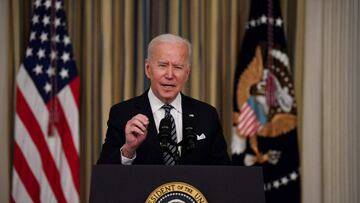$1400 third stimulus check: will I get it in the bank or in the mail?
The IRS began distributing the new direct payments over the weekend and will use a combination of direct deposits, physical checks and debit cards to get the support to those in need.


After taking months to get the package through Congress, President Joe Biden is not wasting any time to get the third round of stimulus checks out to those in need.
The American Rescue Plan includes a round of $1,400 stimulus checks and the White House confirmed that the first wave of payments began landing in bank accounts over the weekend. Today Biden confirmed that his administration have set the target of getting 100 million payments sent in the next ten days, which comes during the middle of a busy time for the IRS.
Not only are the tax authorities in charge of distributing the direct payments but are also overseeing the tax returns filed for 2020. The IRS will use three different methods to get the money out to the people, so will your stimulus check payment arrive in your bank account or in the mail?
Who will get their stimulus check as a direct deposit?
With such an enormous workload the IRS will be looking for the most efficient way to get the money distributed and in most cases that will be through the use of a direct deposit into the recipient’s bank account.
The IRS will already have bank account details on file for most people from the most recent tax returns, so this is how the majority of the payments will be made. Those who file taxes or receive Social Security payments will have already given their details.
President Biden said that his administration was on pace to achieve two key goals by March 25: 100 million shots of Covid-19 vaccines since his inauguration and 100 million direct payments under his economic relief bill. https://t.co/IYPqwjIDef pic.twitter.com/Q3FuR6SwFR
— The New York Times (@nytimes) March 15, 2021
This method uses electronic payment and will be by far the quickest way to get the money. The American Rescue Plan was signed into law last Thursday and by Friday some were already reporting a payment from the IRS was pending in their bank account. Those in this group stand a good chance of getting their stimulus check payment in the next ten days.
Who will receive their stimulus check in the mail?
Given that around 150 million people are expected to be eligible for the direct payment the IRS will have to utilise different methods to get the money out to those in need, two of which rely on the money being physically sent to the recipient.
The IRS will not be sending on wads of cash, but will use physical checks and debit cards to distribute the money to those who they cannot reach with a bank transfer.
Update from Administration re direct payments:
— Jon Ossoff (@ossoff) March 13, 2021
- The stimulus checks have begun to hit bank accounts. 💸
- Taxpayers with direct deposit info on file with the IRS will receive the funds that way.
- Otherwise, the payments will arrive via check or debit card in the mail.
Eligible Americans who do have access to formal banking facilities but whose details are not on file with the IRS will most likely get their money in the form of a physical check, sent to their home address. Given that the authorities will have to produce sort and distribute the checks they are expected to be sent out around a week after the bank transfers are made.
Related stories
The other option for a physical payment is through the use of an Economic Impact Payment (EIP) debit card. The prepaid Visa card will be sent to their home address and can be spent in shops or online, just like a regular debit card.
This will be reserved for those who do not have access to a formal bank account, or whose details are not on file with the IRS. These will take longer to produce so are expected to be distributed around a week after the physical checks are sent, meaning that they will likely begin sometime towards the end of this month.

